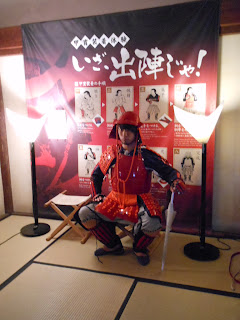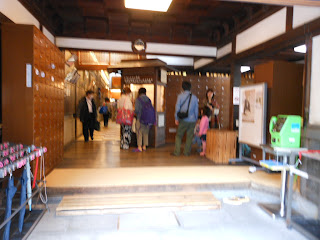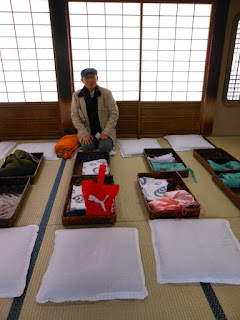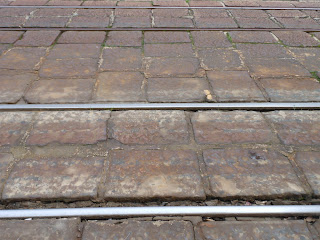I was invited to visit Matsuyama, a city in Ehime prefecture on Shikoku. On the map above, you can see Matsuyama in the northwest, Tokushima is in the northeast.
My cooking teacher, Hiroko Sueda's parents live there and they invited me (us) to stay at their house. So Hiroko, her husband and I took off at 9am on a very hazy ride (due to the Kosa winds from China and an overcast - but not too cold - day) to Ehime Prefecture and Matsuyama. Ehime is know for different types of oranges and tangerines. They say 'orange juice runs from the taps' and also for a type of pottery called Tobe yaki, named after the area that the clay comes from.
About 2 1/2 hours (out of 3) into the ride we stopped at one of the 'roadside oasis' or rest stops for a really high tech trip to the restroom. Look at this!!
 |
| Tells you which toilets are western or Japanese, which have baby changing tables and which stalls are empty!!! Unbelievable! |
 |
| Instructions. |
 |
| Special features inside including a place to hang a cane. The white thing on the right has a disenfecting soap so you can wash the toilet seat |
 |
| Spotless. Often the case in the rest stops, not necessarily in all public restrooms though. |
 |
| Even a pretty flower arrangement! |
 |
| OK, out of the restroom and into vending machine heaven. Coffee, black, with sugar, cappacino, green tea latte, cold drinks, various hot and cold teas, corn soup, ice cream, etc. |
 |
| A gift shop of course. |
 |
| And a little cafeteria type place. With orange soft cream - but we'll be eating lunch soon so maybe on the way home tomorrow.... Mostly noodle dishes but a few rice dishes as well. |
Hiroko had wanted to pick up some special orange bread at the gift shop but they were out! Back on the road and she called her daughter who was going to meet us for lunch, told her about the lack of special bread and was informed that there is a store that sells it next to the gas station she wanted to stop at! After getting our supplies (of orange bread) we made our way into Matsuyama and to a restaurant which is part of a company, or in a building (not quite sure), which Hiroko's elementary school classmate runs (along with many of the rest stop oasis').

 |
| Private rooms. |
 |
| Open areas. |
 |
| On the left is rice covered in sweetened egg, meat, salmon |
 |
| Mine. I love being able to have all these little tastes! |
 |
| Sashimi, tempura |
 |
| Taro, fu, tofu, kabocha, shrimp, brocolli |
 |
| Spinach or nana hana or komatsu?, pickles |
 |
| Misato (daughter), Sueda san, Hiroko |
We were given coffee and dessert as a 'service' (on the house). I loved the cup and saucer.
Misato left us to do some shopping. She lives in Matsuyama and is a obstetrician.
We went on to the Matsuyama castle.
 |
| We took the lift since we had so much to do and not that much time. |
 |
| The plums were blooming! |

 |
 |
| The castle's character... |




The best slippers in a public building that I've ever worn! Usually they're VERY slippery and always fly off my feet. And they're even harder to keep on climbing and descending the EXTREMELY steep stairs of castles. I don't know what these are made of but they were great!!!
 |
| Steep stairs. |
 |
| Armor |

 |
| View from the castle. |

 |
| Enlarge to read the history of the castle. |

 |
| Evidently old style nails were made of steel and in the same way as swords. They didn't corrode. |





Trying on samurai armor
 |
| No matter where one is, sitting on the floor is the norm. |
 |
| The highest tower. |

 |
| There are little metal links on this shirt. |

 |
| Tobe yaki |
Botchan (坊っちゃん) is a novel written by Natsume Sōseki in 1906. It is considered to be one of the most popular novels in Japan, read by most Japanese during their The story is based on the author's personal experience as a teacher being transferred to Matsuyama, which sets the stage for this novel. Natsume was born in Tokyo, and dwelling in Matsuyama was his first experience living elsewhere. The novel reflects his feelings during that experience.childhood. The central theme of the story is morality.
Natsume Sōseki (夏目 漱石, February 9, 1867 – December 9, 1916), born Natsume Kinnosuke (夏目 金之助), is widely considered to be the foremost Japanese novelist of the Meiji period (1868–1912). He is best known for his novels Kokoro, Botchan, I Am a Cat and his unfinished work Light and Darkness. He was also a scholar of British literature and composer of haiku, kanshi, and fairy tales. From 1984 until 2004, his portrait appeared on the front of the Japanese 1000 yen note. In Japan, he is often considered the greatest writer in modern Japanese history.[citation needed] He has had a profound effect on almost all important Japanese writers since.[citation
I read this book but it didn't translate well... The thing is, the author (through the main character) constantly put down Matsuyama and Shikoku in general because it was a 'country place full of uneducated, rude, hicks, etc. etc..... But they use him as a tourist attraction. Dogo onsen (hot springs) was his favorite place in the town, that's still here. And there is a 'Botchan train', Botchan sweets, a museum, a special clock etc. Whatever it takes to bring in the tourists I guess.
 |
| The characters from Botchan |
Onto Dogo Onsen... there is a special area for the royal family who used to bathe there (now they use onsen in various hotels). You can get a tour which includes the royal toilet (a very fancy hole in the floor).
Legends of Dōgo Onsen
In Dogo, two legends were handed down.Legend of egret
Long ago, many egrets lived in Dogo. One day, an egret who injured his shin found a hot spring there. He soaked his shin every day in the hot water. Eventually the egret became well and flew away. People who watched this situation also soaked in the hot spring and their health improved. The news spread that the hot spring was beneficial for ones health, and the hot spring became popular.
Legend of Tama no ishi
A long time ago, there were two small gods, Okuninushi no Mikoto and Sukunahikona no Mikoto. They came from Izumo to Dogo. Sukunahikona no Mikoto contracted a bad illness and his days were numbered. Ookuninushi no Mikoto made Sukunahikona no Mikoto soak in the hot spring. Sukunahikona no Mikoto regained his health, and danced on a stone in the hot spring as proof of his vigor. At that time, his footprint was left, and there is now a stone called Tama no ishi that is exhibited at Dogo Onsen.[1]In popular culture
The main building in the movie Spirited Away was modeled on the present building of the Dōgo Onsen public bathhouse.
 |
| An earlier holding tank for the onsen water. |
 |
| Dogo |
 |
| Dogo onsen, a maze of rooms and baths. |
 |
| Egrets are the symbol of the onsen and the town. |
 |
| Entrance |

 |
| Dogo onsen |

After a nice soak we took a little walk and came across this pretty little park. This is the flower of Ehime. And the flowering tree is peach.
Then we went off to meet Hiroko's parents and to go to dinner. Her parents are 86 and 90 and enjoy meeting foreigners. They have a very nice house and a bird named Pika. We went to one of their favorite restaurants since her dad recently gave up driving (voluntarily) and so they can't really get there any more. It was a fun dinner, good food and better company!
 |
| Sea bream sashimi with a sesame sauce and seaweed. |
 |
| Beef and ? with onion and a sweetish jelly sauce |
 |
| Squid with shiso, daikon and seaweed. |
 |
| vegetables and a fu dumpling |
 |
| Cold tofu, vegetables. |
 |
| An egg fried in panko breadcrumbs |
 |
| Someone else's sashimi, beautiful presentation. |
 |
| birthday tart for Hiroko's mom (March 22) |
 |
| Hiroko's mom and dad. |
 |
| I love the 'hole's under the table, so much more comfortable. |
 |
| Other options. |
After dinner we headed home, watched a little tv, admired Pika and went to bed.
Hiroko and I shared the guest room.
 |
| The alter. |

 |
| The alter insence and bell. |
 |
| Pika |






















 Different types of joints.
Different types of joints.





















No comments:
Post a Comment